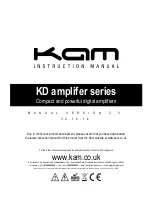
1962 OPERATORS’ MANUAL
2
INTRODUCTION
The 1962 is a hybrid vacuum tube/semi-conductor, dual-channel pre-amplifier which
features extremely low noise operation and the option of a 24-bit digital output. Balanced
microphone and line inputs are included making the 1962 a powerful and versatile tool in
all areas of audio, including studio recording, live sound, location recording, post-
production, mastering and as part of a musician's rack system.
In addition to providing 'clean gain', the 1962 includes variable high and low-pass shelving
filters, a 3-band 'sweetening' EQ, high and low frequency enhancement plus a switchable
peak limiter. A variable Tube Drive system enables the user to apply a precise amount of
tube colouration while a simple mixing system provides level and pan control for each of the
two channels.
The optional D62-T or D62-A digital convertor module may be ordered with the 1962 or
retrofitted when required and provides 16, 18, 20 or 24-bit wordlength outputs in both
AES/EBU and S/PDIF formats with user selectable dither. The D62-T also includes a
Tascam™ T-DIF interface while the D62-A has an integral ADAT™ optical interface. Word
sync in and out is provided as standard and the user may select between 48kHz, 44.1kHz
and externally clocked sample rates.
This manual will refer to the digital module as the D62
wherever it is applicable to both T-DIF and ADAT.
One major advantage of the hybrid approach is that it combines the dynamic range,
reliability and stability of modern solid-state designs with the warm, detailed sound of
vintage classic tube designs. The microphone input stages feature extremely low noise,
balanced input circuitry followed by true, high voltage tube amplification, enabling modern
microphones to take on the characteristics of older tube models. Phantom power is
individually switchable on the two microphone inputs and each microphone input has a
phase reverse switch.
The line/instrument pre-amplifiers are compatible with a variety of signal sources, from
electric guitars and basses to stereo electronic keyboards and synthesizer modules. By
overdriving the tube stage, tonal colouration may be added to an instrument, and with the
addition of an external speaker simulator, overdriven guitar, synth or organ sounds may be
Direct Injected into the mixing console.
There are two, dual-stage tubes in the audio signal path and, in order to maintain optimum
signal purity, the EQ, enhancement and tube drive stages may be switched out of circuit to
provide a minimum signal path between the input and output. To maintain the highest
possible signal-to-noise performance, continuously variable input gain controls are used
instead of rotary switches and high resolution, 24-element LED metering is provided along
with peak overload LEDs. Output level metering and gain control is provided and each
channel has a switchable limiter, which can be used to prevent unwanted overloading -
particularly important when driving digital equipment or when using the optional digital
output stage. A Gain Reduction LED monitors the limiter action. Console-style insert points
on the rear panel allow additional processing to be added to the signal path.
Up to a maximum of three additional stereo analogue signals can be mixed together with the
internally processed signal(s) by utilising the rear panel connector. Providing a facility to fit
only one 1962 with the D62 analogue to digital convertor module.
Содержание 1962
Страница 1: ...i 1962 DIGITAL VACUUM TUBE PRE AMP OPERATORS MANUAL...
Страница 26: ...1962 OPERATORS MANUAL 22 BLOCK DIAGRAM...







































